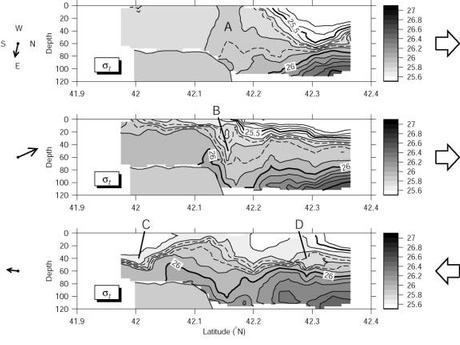Cross-Frontal Exchange and Scotian Shelf Cross-over Workshops
10-12 October, 2000
Holiday Inn, Falmouth, Massachusetts
|
Cross-Frontal Exchange and Scotian Shelf Cross-over Workshops 10-12 October, 2000 Holiday Inn, Falmouth, Massachusetts |
|
Overview
Cross-Frontal Exchange
Presentations
|
Modification of Internal Tide Features by Cross-over Events Andy Dale and Jack Barth, COAS, Oregon State University. SeaSoar surveys of the NE Flank of Georges Bank during the period Mar 30 - Apr 11, 1999 provide us with three-dimensional pictures of intermittent and patchy Cross-overs of Scotian Shelf water onto the Bank. Four `radiator pattern' surveys were made across the Bank edge, with each survey taking around two (M2) tidal cycles and each north-south line around a quarter tidal cycle. Interpretation of the observed fields must take into account the significant advection due both to the tide and the background flow. Ordering the north-south lines by tidal phase reveals the modification of internal tidal features by cross-over events. Stratification over the Bank, resulting from cross-overs of Scotian Shelf water, creates a system analogous to the thermally-stratified summer case described by Loder et al. (1992). Internal tidal mechanisms may then contribute to the erosion and assimilation of the intruding Scotian Shelf water. At times/locations when water over the Bank is well mixed as far as the steep northern flank, the (significant) cross-bank component of the barotropic tide advects stratified off-bank water across the Bank edge. In particular, warm, saline slope water near the bed is pushed onto the bank with substantial distortion of isopycnals. During off-bank tidal flow all stratified waters are carried off the bank. ADCP velocities close to the bed near the bank edge show a tidal phase lead over those higher in the water column, resulting in significant vertical shear (ongoing work is examining the vertical structure of the tide). There is clear evidence that a well-mixed column of relatively warm, saline water near the bank edge contains slope water that has been mixed towards the surface (labeled A in Fig. G1a below). When the bank is stratified by Scotian Shelf water, off-bank tidal flow leads to a lee wave or hydraulic jump (B in Fig. G1b below) anchored in deep water slightly off the bank edge. Isopycnals show vertical displacements of up to 80m as they pass through this feature, with corresponding distortions of the chlorophyll fluorescence field. On reversal of the tide, the substantial internal energy of the lee-wave/jump is released as internal solitary waves/packets which propagate both on and off-bank. These internal waves can be seen in SeaSoar sections (C and D in Fig. G1c below), but are not well resolved. The on-bank propagating signal travels at around 0.5 ms-1 (plus or minus tidal advection which is of comparable magnitude), and may be expected to release much of its energy to mixing when it reaches the on-bank edge of the Scotian shelf water. The importance of this mechanism relative to other mixing processes, such as bottom and surface stirring, remains to be determined, although Brickman and Loder (1993) estimate that the contribution is significant. In addition, mixing may take place in the region of the lee-wave/jump, and may be evident in the finescale SeaSoar data (Dave Ullman). 
Figure G1: North-south sections of References: Brickman, D. and J.W. Loder. 1993. Energetics of the internal tide on northern Georges Bank. J. Phys. Oceanogr., 23, 409-424. Loder, J.W., D. Brickman, and E.P.W Horne. 1992. Detailed structure of currents and hydrography on the northern side of Georges Bank. J. Geophys. Res., 97, 14331-14351. |